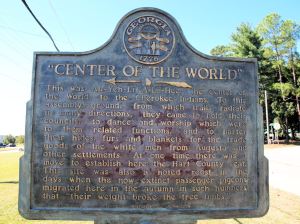Jamie Jenkins: The Center of the World
Just a few miles south of Hartwell, Georgia there is an historical marker and stone monument that declare that this spot is the "Center of the World." When you see the marker and note the rural surroundings you wonder how that designation came to be.
If you stop and read the marker you learn that this is the spot that the Cherokee Indians called "Ah-Yeh-Li A-Lo-Hee ... the center of the world to the Cherokee Indians. To this assembly ground, from which trails radiate in many directions, they came to hold their councils, to dance and worship which were to them related functions and to barter their hides, furs, and blankets for the trade goods of the white men from Augusta and other settlements. .. This site was also a noted roost in the days when the now extinct passenger pigeons migrated here in the autumn in such numbers that their weight broke the tree limbs."
The Cherokees inhabited the mountainous region of the South long before the arrival of Europeans. Historical and archeological evidence shows that the Cherokees settled in this area many generations before the Spanish arrived in the sixteenth century. Gold was discovered in the territory in 1829 and the next year Congress passed the Indian Removal Act. On the basis of that congressional action President Andrew Jackson was authorized to negotiate treaties with Native American tribes.
The leaders of the Cherokee Nation were divided on what response they should give to the efforts to separate them from their land. Some believed either warfare or negotiation with the U.S. government was the answer but others favored removal in exchange for financial compensation. The latter group signed the Treaty of New Echota although some say it was not legal. This "illegal" treaty was then signed by President Andrew Jackson and it passed by one vote in the U.S. Senate.
The opposing faction opposed implementation of the treaty and were forcibly removed by the military. Thousands of Cherokees died on the westward migration during the winter of 1838-1839 on what is commonly known as the Trail of Tears. The descendants of those who were removed became known as the Cherokee Nation of Oklahoma. A smaller number of Cherokees avoided forced removal and remained in the mountains of North Carolina. They became the Eastern Band of Cherokee Indians.
Thus the historical marker in northeast Georgia is the sole reminder of dramatic changes that occurred 175 years ago. The "center of the world" for the Cherokees shifted in ways they could have never imagined.
This is a reminder that nothing is permanent. One thing that you can count on is change.
It is so easy to feel like whatever we are doing is the most important activity on the planet and wherever we are is the center of the world, if not the center of the universe. And much of the time that feeling is probably alright. At the same time I am reminded of what the Cherub Choir sang last Sunday morning, "He's got the whole world in His hands... He's got you and me brother/sister in His hands."
God cares equally for all of us. While at any given moment we might think that all the world centers on us, we must not deceive ourselves to think that we are the most important and that our privileged position must be maintained. We must also be careful not to destroy others' "center of the world" for our own gain.
The hymn writer had it right: This is my Father's world. O let me ne'er forget that though the wrong seems oft so strong, God is the Ruler yet.

